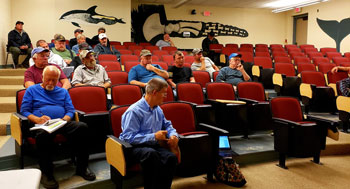DMR Proposes Drag Restriction Lift, November Diving at Scallop Hearings
by Sarah Craighead Dedmon

Roughly 25 people attended the Machias scallop hearing on Sept. 11., far fewer than last year’s hearing which put more controversial subjects on the agenda. Photo by Sarah Craighead Dedmon.
The Maine Department of Marine Resources held a series of public hearings last month to discuss proposed changes to its Atlantic sea scallop management program for the 2018-19 season.
This winter’s scalloping season will be the seventh for the DMR’s rotational scallop management plan, first implemented in 2012. The plan organizes the coast of Maine into three management zones, with each zone given specific guidelines that regulate the length of the season, catch limits and fishing days according to the health of the local scallop population.
Since implementation of the rotational management plan, Maine’s scallop fishery value has rebounded from $1.5 million in 2010 to an estimated $9.3 million last season.
Scallop Resource Manager Melissa Smith conducted the hearings, which took place in Augusta, Machias and Ellsworth, together with DMR Hearings and Regulation officer Amanda Ellis.
“The Scallop Advisory Council meeting in July lasted three and a half hours in which we discussed everything that went into this document,” said Smith, referring to the 2018-19 agency rulemaking proposal handed out to meeting attendees and available online at www.maine.gov.
The Machias hearing held on Sept. 11 drew about 25 fishermen and marine patrol officers, a great many fewer that last year’s hearings when the controversial subject of how to issue new licenses was on the agenda.
Days
In the DMR’s proposal, season length in zones 1 and 2 didn’t change from the 2017-18 season, with zone 1 remaining at 60 fishing days for divers and draggers alike, and zone 2 set at 70. But in zone 3 the DMR proposed reducing fishing days from 55 to 50.
The proposal also
suggests splitting the
zone 3 fishing week
evenly between
draggers and divers.
“From a lot of conversations I had with the industry in the last season, there was a consensus that there was no reason to have a 55-day calendar in an area that would not reach that,” said Smith, referring to Cobscook’s frequent need for late-season emergency closures in response to stock assessments.
The proposal also suggests splitting the zone 3 fishing week evenly between draggers and divers, with draggers taking Monday through Wednesday and divers fishing Thursday through Saturday, something Ralph Dennison said he was glad for.
“I’m in favor of the three-day-on, three-day-off season in Cobscook Bay,” said Dennison, a diver from Trescott. “When they used to have the Cobscook Fishermen’s Association we had a three-day season up there for a reason. I’m glad they’ve decided to go back to it.”
There are no proposed changes to the daily catch limits, with zones 1 and 2 remaining at 15 gallons per day and zone 3 at 10 gallons per day.
“We looked at the drag and dive calendars for all zones, with a lot of time being spent on zone 1,” said Smith. Ultimately the DMR proposed five November dive days for zone 1, opening on Nov. 20.
“Hypothetically [divers could] get product for the Thanksgiving market,” said Smith.
Concerning the internationally-contested Machias Seal Island, Smith said that though it was opened for the entire month of March last year, this year she proposed opening it for the entire month of January, only as a place to begin discussion. Both the United States and Canada claim ownership of the 20-acre island, which falls in the waters of Maine’s zone 2. Fishermen may always drag there on zone 2 fishing days.
Drag size
I think you’re going the
wrong way on drag size.
– William Anderson, Trescott
The subject of changing drag size restrictions was first broached in 2016, said Smith, and this year the DMR proposed removing specific drag gear restrictions in the Kittery area, Swan’s Island Conservation area, and Gouldsboro Bay.
“If amended, harvesters would be able to utilize any drag size, provided it does not exceed the State maximum of 10’6”,” reads the proposal.
William Anderson of Trescott spoke in opposition to the proposed change.
“I think you’re going the wrong way on drag size,” said Anderson, noting the small size of Gouldsboro Bay where drag size has historically been capped at 4’6”.
“As far as I’m concerned we’re trying to rebuild this resource. I really feel like we should have smaller dredges.”
Dennison agreed. “I think the drag size in statute should remain,” said Dennison. “I just want to say I hope this gets passed as written.”
Divers
The DMR also proposed lifting a sunset provision rule that caps the amount of scallops divers can bring in if they’re sharing the same vessel. Currently each diver is limited to 15 gallons, and only two divers are permitted to be harvesting from the same vessel. For the next season the DMR proposes allowing more divers to catch their limit from the same boat.
“This was sunsetted for November 2018,” said Smith. “It is again being offered for comments.”
One fisherman voiced his frustration that multiple scallopers can fish from the same boat, but multiple draggers may not.
Smith explained that draggers hold an owner/operator license which is attached to the vessel, whereas diver licenses are attached to the individual.
“That’s a law, there’s nothing we can change in a regular meeting, that has to be changed in [statute],” said Smith.
The Machias meeting lasted only 35 minutes. The DMR closed its comment period on Sept. 24. Smith said 2018-19 maps will be available online in early October, and that people requesting paper maps should expect to receive those in the mail mid-October.
For more information on Maine’s Atlantic Sea Scallop fishery, visit www.maine.gov/dmr/science-research/species/scallops.
